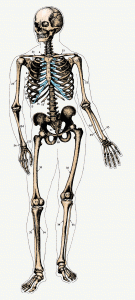Standing on two legs is not easy. We are supposed to stand upright with our skeleton perpendicular to the floor—the spine and the extremities are meant to emanate from the pelvis in the same plane. If I were to hang a carpenter’s plumb line from the height of someone’s head, the string should follow a line through the center of the ear, shoulder, hip, knee, and ankle.
The pelvis has to be aligned correctly for that to happen. This would mean that the spine and the legs follow that same carpenter’s plumb line to the ground. It is very different for our four-legged friends—the spine of a quadruped sits horizontally on its pelvis and shoulders. Life is much easier if you don’t have to balance your spine vertically on top of the pelvis– things became much more difficult for us to manage when we came up to stand. Your average quadruped doesn’t get an achy back.
When we came up to stand the base of the pelvis had to become much more supportive and stable. To walk bipedally, the legs moved underneath the pelvis which actually makes the balancing act more difficult still. The muscles of the pelvis become way more taut and toned in order for the legs to ambulate under the hips. This complicated our journey from the womb to the world.
The miracle of human birth is radically different from that of its mammalian predecessors. Where most animals are walking within minutes of being born, we take a year or more to get up and move on our own. In the context of the uncivilised animal kingdom that we came from, the human baby is completely vulnerable, unable to care for or defend itself.
We come out into the world at an earlier stage of development than other animals for a number of different reasons. Our head and brain size requires that the baby come out lest it not pass go through too small a hole. The new tone that came to the muscles of the pelvic floor also limited the pelvic outlet‘s ability to open. In an interesting shift the pelvis that is the back wall of a quadruped pelvis became the floor of a bipedal man/woman.
This shift has radically altered the role of what is now the base of our pelvis. The levator ani muscle helps to support the weight of our organs and its tone controls our urogenital function.
If a quadruped, let’s say a horse, is in labor and you were so inclined, a helping hand would be free to reach inside and assist in the removal of the foal—this is not going to happen in humans. Here is another example of the difference between the quadrupedal pelvis and ours. Imagine you are on a horseback ride and the horse in front of you blithely evacuates his or her bowels— this is hopefully not going to happen in humans. Our pelvic floor has more resting tone than any other muscle in the body simply to keep us from going to the bathroom constantly.
It is not easy to be us and working with people in pain is a constant reminder of how simple it is for our bodies to fall out of balance and cause us discomfort. The more we know about how and why the body works the way that it does the more likely we are to lead a pain-free life.
***


